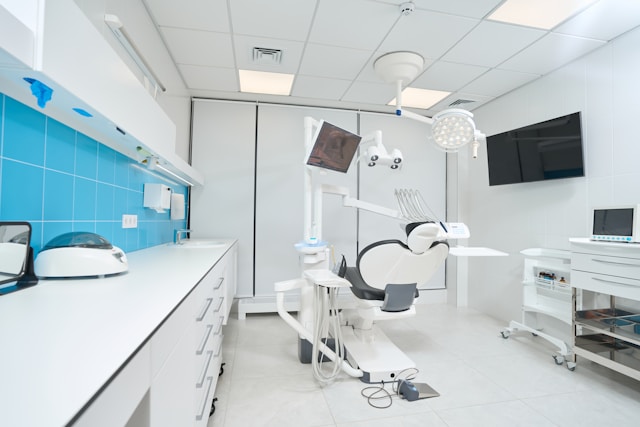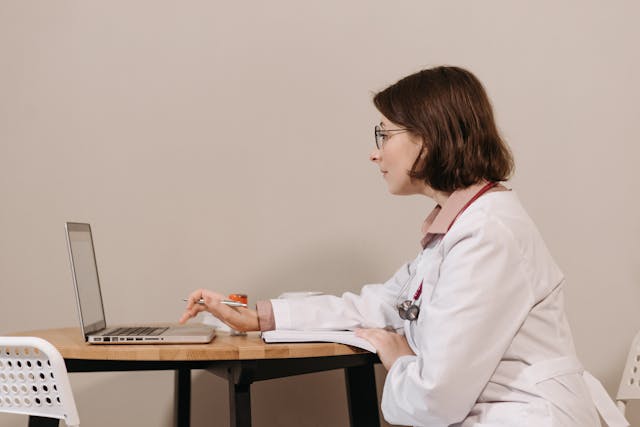Importance of healthcare provider and patient communication
Effective communication between healthcare providers and patients is foundational to successful medical care. Clear and empathetic interactions build trust, a critical component in any healthcare relationship. After all, we're not robots that dispense medical advice—we're professionals caring for real people with unique needs and concerns. And no patient wants to leave their health at the hands of a stranger they don't trust.
However, being a professional does not necessarily make it easy to speak professionally. Imagine trying to write a professional email when, just five minutes into your shift, five different machines start beeping, a couple of phones start ringing, there's already a queue for admissions, and a patient is wandering down the hallway. Difficult, right? Or how about this—a patient insists they followed their diet to the letter, but their blood tests sing a wildly different tune.
These moments test our resolve and remind us why clear and compassionate communication is vital, not just in crisis but daily. And so, we're here to help you write those emails—so that even when things get rough, you can keep your emails sounding nice and smooth.
How to Write an Email to a Patient: Tips for Success
Clear and concise communication is the key to a stronger patient-provider relationship. Let's delve into the specific tips that can help streamline and enhance your email communications with patients:
1. Select a professional email address
Establishing trust with your patients starts with the basics, like using a professional email address. An email incorporating your name or role within the practice sends a message of professionalism and reliability right from the start.
For instance, an email address like Dr.Kim@yourclinic.com or J.Alwyn.RN@healthcare.org clarifies who you are and your role, enhancing your credibility before the patient even reads your message. It's like wearing your badge digitally—simple but effective. In contrast, a patient would probably think they got the wrong address if they saw xXxGamer99xXx@email.com or h1gh_sch0ol_qu33n or something similar—even Gen Z knows you should retire email addresses like these.
2. Construct a compelling subject line
The subject line is your email's handshake—it must be firm, clear, and inviting. This is your first (and sometimes only) chance to grab your patient's attention, and it may decide whether that email is opened or sent to the spam folder.
A well-crafted and concise subject line should summarize the purpose of the email, encouraging the patient to open and read it. For example, "Appointment Confirmation," "Lab Results Update," or "Follow-Up on Your Recent Visit" are all straightforward and set the right expectations.
Think of it as the headline of a newspaper article. If it's vague or overly cryptic, the email might be overlooked or lost in a busy inbox. Also, avoid using caps lock or overly promotional language like "OPEN NOW" or "URGENT," which can come off as spammy. Instead, keep it relevant and personal, possibly even incorporating the patient's name, such as "Matty, Your Upcoming Surgery Details" or "Taylor's Treatment Plan Update."
3. Personalize your greeting with the patient's name
Starting your email with a personalized greeting shows professionalism and demonstrates your attention to detail and care for the individual. Addressing your patients by name helps to establish a connection and makes the communication feel more tailored and considerate.
For example, opening with "Dear Travis" or "Hello Ms. Swift" immediately makes your email more engaging. It shows that the message isn't a generic broadcast. This approach meshes well with referencing specific details from previous interactions, such as mentioning an activity they did or a food they ate that they brought up in your previous conversation. Such touches help to reinforce the relationship, reminding patients that they are not just numbers but valued individuals in your care.
Mentioning the patient's name is not the end goal—what really works is paying attention to the patient. But mentioning the patient's name is just one way of showing that you pay attention. It is a simple yet powerful way to enhance trust and open lines of effective communication.
4. Be concise and direct for effective communication
When writing emails to patients, clarity and brevity are your best friends. Keeping your messages concise and direct respects your patients' time and ensures that your communications are effective and straightforward. It also keeps you from overwhelming your patient with unnecessary details, which might sidetrack them or overstack their cognitive load.
For instance, bullet points can be used to break down information into digestible pieces instead of a lengthy exposition. If you're providing instructions for a new medication, lay out the steps clearly:
- Medication name: Take once daily before bedtime
- Dosage: 100 mg
- Purpose: To manage blood pressure levels
This format helps patients quickly grasp the key points without sifting through dense paragraphs. Remember, most people aren't looking for a medical lecture in their inbox; they want clear, actionable information they can easily understand and act upon.
5. Speak their language
Effective patient communication often hinges on your ability to present information in an easily accessible way. As such, avoid complex medical jargon that might confuse or alienate your audience and opt for plain language instead. Ensure your message is clear and your instructions are easy to follow. For example, rather than referring to a "laparoscopic cholecystectomy," you might explain it as "a minimally invasive surgery to remove your gallbladder." This approach helps prevent misunderstandings and fosters a better therapeutic relationship.
Using familiar words and phrases makes your emails more relatable and less intimidating. This adaptation in language shows that you are transparent and that you value your patients enough to keep them out of the dark, enhancing their trust and engagement with your guidance.
6. Provide clear instructions
Clarity is paramount when communicating medical information or instructions via email. Patients must understand exactly what is expected of them to ensure compliance and achieve the best health outcomes and patient satisfaction. This means crafting your message in a way that leaves no room for misunderstanding.
For instance, if you're instructing a patient on how to prepare for a medical test, detail every step they need to take, such as fasting requirements, specific times for medication intake, or what documents to bring on the day of the appointment. Here's how you could structure such an email:
- Pre-test preparation for [test name]:
- Fasting: Do not eat or drink anything except water for 12 hours before the test.
- Medications: Continue taking your regular medications unless advised otherwise.
- What to bring: Please bring a photo ID and your insurance card.
Moreover, consider ending the email with an invitation to contact your office for clarifications, reinforcing that support is just an email or phone call away. This approach helps achieve compliance and builds trust, as patients know exactly what to do and whom to reach out to if they have further questions.
7. Ensure accuracy before sending your message
Remember how embarrassing it was to send misspelled messages to your professor? I bet you do. Ensuring that your email communications are free from errors is not just about professionalism; it's also about maintaining trust and clarity in your relationship with patients. An email riddled with typos, grammatical errors, or incorrect information can confuse patients and diminish your credibility.
Before hitting send, take a moment to review your email carefully. Check for:
- Spelling and grammar: Use tools like spell check or Grammarly to catch common errors. Even a quick read-through can prevent simple mistakes. Especially if you're using outdated speech-to-text software, "sick as hell anemia" sounds cool, but not so much in real life.
- Accuracy of information: Verify that all medical details, appointment times, and instructions are correct. Misinformation can lead to serious misunderstandings—you don't want to be lumped in with some kooks on the internet!
- Tone and clarity: Ensure the tone and message are appropriate and easy to understand. Avoid ambiguity that could lead to patients misinterpreting the advice.
Doing all these can take maybe a minute or two, but if you overthink your messages, it might take a bit longer. The benefits still outweigh that time spent, especially if you spot errors!
8. Convey warmth and empathy when communicating
While email is a convenient medium for quick exchanges, it lacks the non-verbal cues that often convey warmth and empathy in face-to-face interactions. Hence, it's crucial to infuse your emails with a tone that helps bridge this gap, ensuring your patients feel supported and valued.
Here are a few tips to make your emails warmer and more empathetic:
- Use a friendly and approachable tone: Start with a warm greeting and use a conversational tone throughout the email. For instance, phrases like "I hope you're feeling better today" or "I understand this can be a lot to process" can make a big difference.
- Show understanding and compassion: Acknowledge any difficulties or discomfort they may be experiencing. This can be as simple as saying, "I know this isn't easy, but you're not alone in this journey."
- Use encouraging words: Positive language can uplift the spirits of your patients. Phrases like "You're doing great" or "We're seeing some real progress here" reinforce a positive outlook.
- Personalize your message: Refer to past discussions or personal details the patient shared. This not only personalizes the email but also shows that you pay attention and care about their life beyond the medical charts.
- Sign off warmly: End your emails with a warm closure that invites further communication, such as "Take care" or "Looking forward to hearing from you." It's a simple way to make them feel more at ease and connected to you.
9. Respond at your earliest convenience
Responding promptly to patient emails is crucial, particularly for those with pressing health concerns. Quick replies demonstrate your commitment to their health and significantly alleviate patient anxiety. This reassurance is essential, especially when they are awaiting important medical updates or answers to pressing questions.
Moreover, a swift response fosters a sense of reliability and shows patients that you value their concerns. Responding within 24 to 48 hours, even if it's to acknowledge the receipt of their email and ensure a detailed response soon. When patients receive an acknowledgment, it can significantly affect their experience and stress levels.
10. Always include your contact details
Ensuring your email signature contains complete contact details is more than a formality—it's crucial to patient communication. Including your phone number, address, and other relevant contact information makes it easy for patients to reach out for further clarification or to follow up on their care.
A comprehensive email signature offers patients convenient access to essential details without searching through old messages or external websites. For instance, if a patient needs to reschedule an appointment or has a quick question, having your contact information readily available in every email facilitates smoother, quicker interactions.
Most email platforms like Google and Outlook allow you to set up a permanent email signature that automatically appears at the bottom of every email you send. This setup ensures you never forget to include it, maintaining consistency across all communications.
Examples of patient email templates
Despite those numerous tips, writing emails can still be a bit of a chore, especially if you have to write and send more than a hundred a day. So, to help you out, here are a bunch of templates that you might find helpful:
Appointment reminder template
Subject line: Reminder: upcoming appointment with [clinic name] on [date]
Email body:
Dear [patient name],
This is just a quick reminder about your upcoming appointment with [doctor's name] at [clinic name], scheduled for [date] at [time]. We're looking forward to seeing you and assisting with your healthcare needs.
Please arrive about 15 minutes early to handle any updates to your paperwork. If you have any questions or need to reschedule, feel free to contact us at [phone number].
Thank you for choosing [clinic name]. See you soon!
Best regards,
[your name]
[your position]
If you use Carepatron, the platform will automatically send appointment reminders to your patients. You can customize the template, too — just so you know!
Follow-up email template
Subject line: Follow-up on your recent visit to [clinic name]
Email body:
Hello [patient name],
I hope this message finds you well. We want to ensure that everything is going smoothly after your recent visit to [clinic name] with [doctor's name] on [date].
If you have any questions or if there's anything else we can do to assist you with your recovery, please don't hesitate to let us know.
Warm regards,
[your name]
[your position]
Annual check-up reminder template
Subject line: Friendly reminder: schedule your annual check-up
Email body:
Hi [patient name],
It's that time of the year again! We at [clinic name] are sending a gentle reminder to schedule your annual check-up. These appointments are crucial for maintaining your health and catching any potential issues early.
Please call us at [phone number] or reply to this email to set up your appointment. We're here to keep you healthy!
Take care,
[your name]
[your position]
These are probably the most common ones you'll send out. We also have several other text message templates—check them out if you're interested.
Final thoughts
Writing an email to a patient is an opportunity to show both compassion and professionalism. It's essential to keep the tone clear and respectful while conveying empathy. A thoughtful gesture, like wishing them a speedy recovery, can make the patient feel genuinely cared for. Instead of focusing solely on their actual sickness, offer positive thoughts and encourage their strength. Approach the situation with the same kindness you would show a close friend. If appropriate, you might gently ask about their experience with hospital food and the service they’ve received, which can be a lighthearted way to connect. Above all, keep the email focused on their comfort and healing. Remember, your words can significantly affect their journey back to good health.




.jpg)



.jpg)





.jpg)

.jpg)
.jpg)
.jpg)
.jpg)

.jpg)


.jpg)


